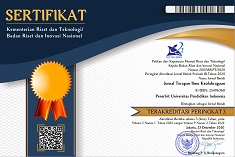Pengaruh Pembelajaran Renang Selama Delapan Minggu Terhadap Peningkatan Kemampuan Dasar Renang Gaya Bebas untuk Pemula Mahasiswa Ilmu Keolahragaan
Abstract
Tujuan study menginvestigasi pengaruh program pembelajaran renang selama 8 minggu terhadap peningkatan kemampuan dasar renang gaya bebas mahasiswa ilmu keolahragaan tingkat pemula. Pengukuran kemampuan dasar renang mencakup; kemampuan menyelam, mengapung, meluncur, gerakan kaki, gerakan lengan, koordinasi gerakan kaki dan lengan, mengambil nafas, dan kemampuan renang gaya bebas lengkap. Subjek penelitian 30 orang (18 pria dan 12 wanita), rentang usia 19 – 21 tahun. Seluruh kemampuan dasar renang hasil pra-postes menunjukkan perbedaan yang signifikan p =0.00<0.01. Artinya program pembelajaran renang gaya bebas selama 8 minggu, memiliki pengaruh yang signifikan terhadap peningkatan kemampuan dasar renang gaya bebas mahasiswa untuk pemula.
Abstract
The aim of the study was to investigate the effect of an 8-week swimming learning program on the improvement of the basic freestyle swimming abilities of entry-level sports science students. Measurement of basic swimming skills includes; ability to dive, float, glide, leg movements, arm movements, coordinate leg and arm movements, take breaths, and complete freestyle swimming. The research subjects were 30 people (18 men and 12 women), age range 19-21 years. All abilities Baseline swimming pre-post test results showed a significant difference p = 0.00 <0.01 This means that the learning program of freestyle swimming for 8 weeks, has a significant effect on the improvement of students' basic freestyle swimming skills for beginners.
Keywords
Full Text:
PDFReferences
Armbruster, D. A. (1936). Teaching Beginners to Swim. The Journal of Health and Physical Education, 7(4), 242–275. https://doi.org/10.1080/23267240.1936.10627194
Berlant, A. R. (1998). Observational learning and the fearful child: Influence of peer models on swimming skill performance and psychological responses. Research Quarterly for Exercise and Sport, 69(4), 380–394. https://doi.org/10.1080/02701367.1998.10607712
Brenner, R. A., Saluja, G., & Smith, G. S. (2003). Swimming lessons, swimming ability, and the risk of drowning. Injury Control and Safety Promotion, 10(4), 211–215. https://doi.org/10.1076/icsp.10.4.211.16775
Colwin C. (2002). BREAKTHROUGH SWIMMING. Human Kinetics.
Costa Aldo, et al. (2012). Deep and Shallow Water Effects on Developing Preschoolers’ Aquatic Skills. Journal of Human Kinetics, 32/2012, 2. https://doi.org/10.2478/v10078-012-0037-1.
Cureton, T. K. (1939). Standards for testing beginning swimming. Research Quarterly of the American Association for Health, Physical Education and Recreation, 10(4), 54–59. https://doi.org/10.1080/10671188.1939.10622511
Erfan Al Shimaad Zaghlol. (2014). The Effect of Float Tools on Some Basic Skills Performance in Swimming and Some Physiological Variables for Students in Faculty of Psycal Education. MOVEMENT AND HEALTH, Vol. XIV(ISSUE 1).
Hay James G. (1993). The Biomechanics of Sports Techniqes. Prentice-Hall.
Langendorfer, S. J., Quan, L., Pia, F. A., Fielding, R., Wernicki, P. G., & Markenson, D. (2009). Scientific Review: Minimum Age for Swim Lessons. International Journal of Aquatic Research and Education, 3(4). https://doi.org/10.25035/ijare.03.04.12
Lanotte, N., Annino, G., Bifaretti, S., Gatta, G., Romagnoli, C., Salvucci, A., & Bonaiuto, V. (2018). A New Device for Propulsion Analysis in Swimming. Proceedings, 2(6), 285. https://doi.org/10.3390/proceedings2060285
Light, R., & Wallian, N. (2008). A constructivist-informed approach to teaching swimming. Quest, 60(3), 387–404. https://doi.org/10.1080/00336297.2008.10483588
Moran, K., Stallman, R. K., Kjendlie, P. L., Dahl, D., Blitvich, J. D., Petrass, L. A., McElroy, G. K., Goya, T., Teramoto, K., Matsui, A., & Shimongata, S. (2012). Can you swim? An exploration of measuring real and perceived water competency. International Journal of Aquatic Research and Education, 6(2), 122–135. https://doi.org/10.25035/ijare.06.02.04
Novais Maria L. et. al. (2012). “The Effect of Depth on Drag Duringthe Streamlined Glide,” A Three-Dimensional CFD Analysis. Journal Human Kinetics, Volume 33/, 55–62. https://doi.org/10.2478-012-0044-2. Section I – Kinesiology.
Oh, S., Licari, M., Lay, B., & Blanksby, B. (2011). Effects of Teaching Methods on Swimming Skill Acquisition in Children with Developmental Coordination Disorder. International Journal of Aquatic Research and Education, 5(4). https://doi.org/10.25035/ijare.05.04.09
Palmer Adam. (2014). Rebook CrosFit Games Revealed Dramatic Differences in Swimming Efficiency. The CrossFit Journal.
Payne and Isaacs. (1991). Human Motor Development. Mayfield Publishing.
Schaefer, M. A. (1946). Teaching Swimming to the Slow Beginner. The Journal of Health and Physical Education, 17(5), 280–317. https://doi.org/10.1080/23267240.1946.10627329
Scott, M. G. (1954). Learning rate of beginning swimmers. Research Quarterly of the American Association for Health, Physical Education and Recreation, 25(1), 91–99. https://doi.org/10.1080/10671188.1954.10624947
Seifert, L., Chollet, D., & Allard, P. (2005). Arm coordination symmetry and breathing effect in front crawl. Human Movement Science, 24(2), 234–256. https://doi.org/10.1016/j.humov.2005.05.003
Shmidt R. (2000). Motor Learning and Performance. Human Kinetics.
Singer, R. N. (1980). Motor learning and human performance: an application to motor skills and movement behaviors. 549.
Stallman, R. K., Junge, M., & Blixt, T. (2008). The Teaching of Swimming Based on a Model Derived from the Causes of Drowning. International Journal of Aquatic Research and Education, 2(4). https://doi.org/10.25035/ijare.02.04.11
Stallman, R. K., Moran, K., Quan, L., & Langendorfer, S. (2017). From Swimming Skill to Water Competence: Towards a More Inclusive Drowning Prevention Future. International Journal of Aquatic Research and Education, 10(2). https://doi.org/10.25035/ijare.10.02.03
Statkevičienė, B., & Venckūnas, T. (2008). Athletes ’ anthropometrical measurements and physical capacity influence on learning competitive swimming techniques. 9.
Thoke Atmaram V. (2013). Development of Basic Skills in Swimming Sports Training At Grassroot Level trough Distance Education Method: A Case Study on School Going Children”. JOSR Journal of Sports and Physical Education, Volume 1(Issue 1), 11–13.
DOI: https://doi.org/10.17509/jtikor.v5i2.27819
Refbacks
- There are currently no refbacks.
Copyright (c) 2020 Badruzaman Badruzaman, Yudha M Saputra

This work is licensed under a Creative Commons Attribution-NonCommercial-ShareAlike 4.0 International License.





